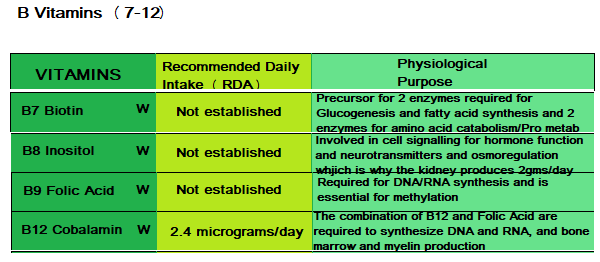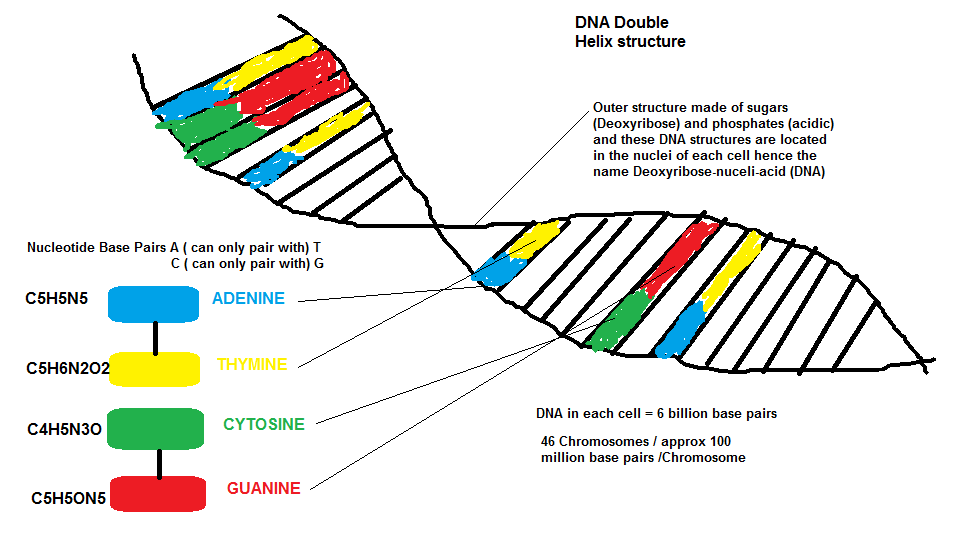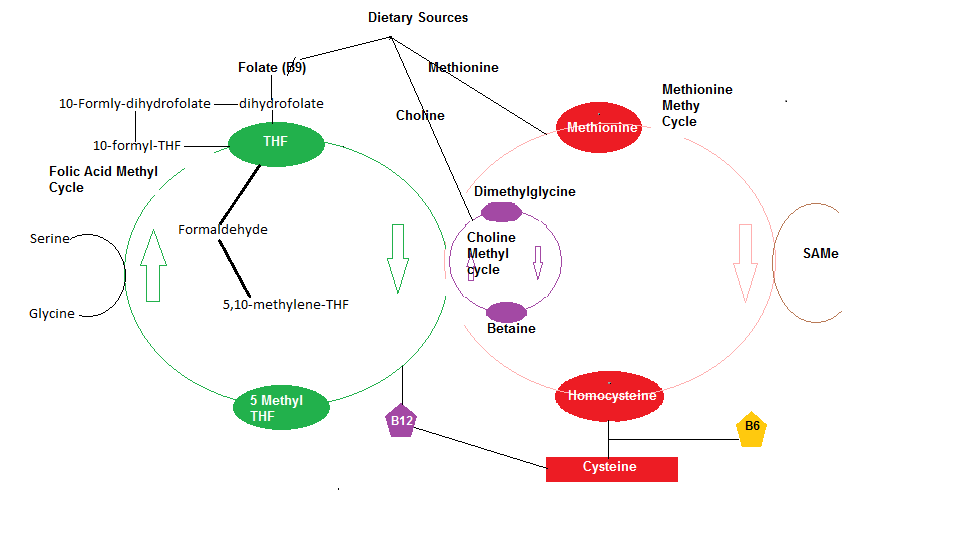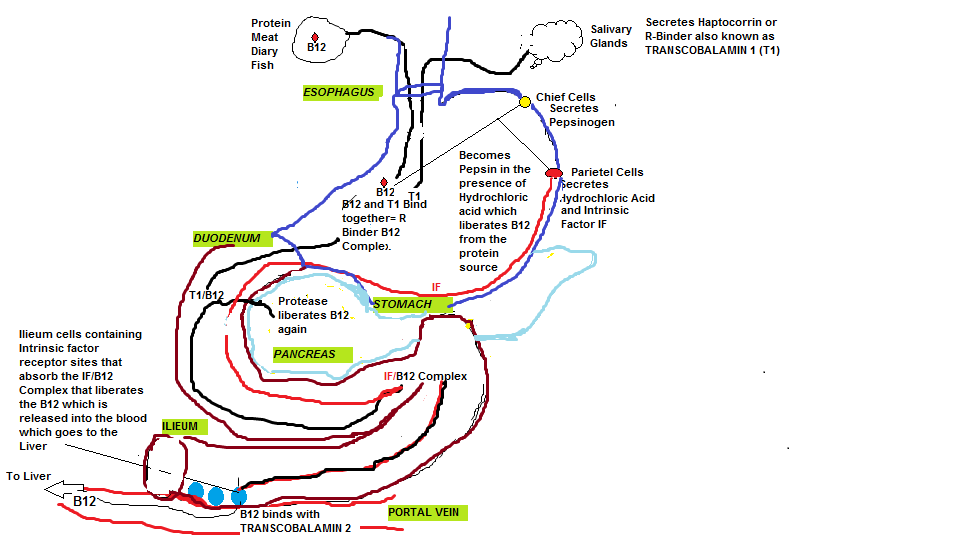These are the vitamins that are discussed in depth in this Part.

Vitamins and DNA
From previous articles we discussed the nucleotide bases made from 4 substances Adenine(A),Thymine (T) Cytosine (C),Guanine (G) and as mentioned previously Adenine synthesis requires Vitamins B3 and B9.
Thymine synthesis requires Vitamins B3, B6 and B9,
Cytosine synthesis requires B3, and Guanine synthesis requires B3 and B9.
There is a requirement for B3 to produce a DNA repair enzyme Poly (ADP-ribose) Polymerase (PARP), so a deficiency in B3 may cause the body not to make this enzyme risking un-repaired DNA.
Because the Vitamin B complex is crucial to DNA structure and repair, deficiency has the same effect as radiation exposure.
Dr. Joel Wallach sued the FDA several times insisting that B9 (Folic Acid) supplementation was essential for mothers to be to avoid certain birth defects (Spina Bifida, cleft palate, cleft lip) and he won the case.
The problem with folic acid deficiency is Thymine synthesis becomes impaired and Uracil is used to replace Thymine, however the repair enzyme removes the Uracil because it is not supposed to be there thus leaving breaks in the DNA strands causing problems in the genetic programming.
Uracil is actually used in place of Thymine in rNA since it is less metabolically expensive to produce.
Thymine is used in DNA since it has a greater resistance to photochemical mutation (from UV light for example).
People whose cuts and scrapes take a while to heal can be due to sluggish DNA due to vitamin deficiency (i.e Folate Acid).
If the deficiency persists over time this could invite cancer to erupt.
 Diagram 1: DNA
Diagram 1: DNA

B Vitamins and Gene Regulation
We discussed briefly in a previous article ‘Microbiome and disease’ Part 1 that methylation is a cycle that occurs within each cell millions of times/second on a daily basis, and is a process of controlled transfer of a methyl group onto amino acids, proteins, enzymes and DNA for, in this case, genetic expression.
When methyl group transfer occurs, it attaches to DNA influencing the expression of genes; generally it is an epigenetic signaling tool that cells use to lock genes in the ‘off’ position when they are not required, if ever, i.e gene expression pertaining to liver function would always be silenced within a heart cell for obvious reasons.
This regulatory process is achieved by DNA chemical tagging to either express a gene or silence a gene.
These DNA chemical tags are used on both the Histones (that DNA is wrapped around) and the genes themselves, because DNA methylation deals with gene silencing and Histone methylation deals with gene expression (anyway more of this stuff will be explained in the article Epigenetics).
In the methylation (Methionine) cycle shown in diagram 2 Methionine which comes from the diet (meat protein for example) is converted to the main methylation donor (SAMe) and within the cycle, SAMe loses its methyl group and is subsequently converted to homocysteine.
Liver cells, with the use of a catalyst Vitamin B6, homocysteine is converted to the amino acid Cysteine which can then be used to form Glutathione or converted back to Methionine using the Methyltetrahydrofolate in the Folic acid cycle assisted by Vitamin B12.
High plasma homocysteine is sometimes an indication of Vitamin B complex deficiency (either singly or a combination of B6,B12,and B9 ( folic acid))
Diagram 2- Simplified Methylation Cycle

Vitamin B12

Diagram 3- The Absorption of Vitamin B12


As you can see from Diagram 3 the production of Vitamin B12 is by far the most complex Vitamin in terms of its bioavailability and absorption.
When dietary B12 is first ingested in the mouth, the salivary glands secrete a substance called Haptocorrin (also know as R-Binder or Transcobalamin 1) which is used to protect the Vitamin B12 from the stomach acid that can destroy it.
Protein foods that contain B12 like meat, dairy or fish is then transported from the esophagus into the stomach for digestion.
The Chief cells of the stomach wall secrete a precursor substance Pepsinogen, when released and mixed with Hydrochloric acid released by the Parietal cells produces a protease substance called Pepsin which is used to digest food and in this case also liberates the Vitamin B12 from the food.
The liberated B12 binds with the Transcobalamin 1 transport and is shipped to the entry of the intestine, the Duodenum where the Pancreas releases several enzymes including Protease (for protein breakdown) and liberates the B12 again from the Transcobalamin 1.
The parietal cells of the stomach wall in addition to the hydrochloric acid secretion also secrete a Glycoprotein (protein with a sugar attached) called ‘Intrinsic Factor’ (IF) which is used to bind the second B12 liberation from Transcobalamin 1.
Once the Intrinsic factor and the B12 are bound the ‘pair make their way to the end of the intestine, the Ileum, where Ileum cells reside, that contain Intrinsic factor receptors.
Once the IF/B12 bound combo reaches the IF receptors on the Ileum cells, the cell attaches the IF and liberates the B12 for the third and last time where it travels through to the Portal vein that transports it via a plasma transport called Transcobalamin 2 to its final destination to the Liver for storage.
Approx 50% of the B12 is stored in the liver and can last for 3-5 years without replenishment, since B12 is secreted in the bile of the Gallbladder and recycled.
Approximately 20% of the B12 is transported to the tissue but the lion’s share goes to the liver.
Within a few hours approx 1.5 micrograms is absorbed.
Depletion depends on the balance between:
1. How much is ingested from the diet,
2. How much is secreted, (normally only 0.1% of the total B12 absorbed is expelled from the body),
3. How much is absorbed.
The amount of B12 that circulates around the body is somewhat of a mystery since there are 23 Bacterial Genera that synthesize this vitamin, and most of them reside in the colon, so any manufactured B12 in the colon will end up in the stool since it is beyond the absorption site in the Ileum of the small intestine. STOP...
So this is where it becomes somewhat of an enigma.
There are many articles and scientific papers that state that any B12 manufactured in the bodies bacterial colonies is beyond absorption since no B12 producing bacteria lives inside the small intestine.
However, I believe this not to be true.
A lifetimes supply of Vitamin B12 is extremely small, some estimate it to be no more than 40 mg speck of red crystal, around one seventh the size of an average Aspirin tablet.
When B12 is excreted in the bile the amount is between 1-10 micrograms/day which is then reabsorbed.
Even vegetarians and vegans have normal B12 levels because of this efficient re absorption process (Correct me if I am wrong but I don’t ‘buy into this’ common theory that vegetarians and vegans have to supplement B12). I also do not ‘buy into this’ notion that B12 producing bacteria do not exist in the gut.
So given that vegetarians and vegans, and for anybody for that matter that have a healthy gut flora, a healthy pancreas, adequate stomach acid, good digestion, and an efficiently functioning liver, than there is every reason for these statements to be false.
Vitamin B12 deficiency is generally not inadequate dietary intake, it is because the B12 manufacturing and absorption mechanism is under attack by the immune system caused by gut dysbiosis which will affect any of the steps needed to successfully metabolise B12.
Conventional medicine calls this Pernicious anemia, whose discovery was attributed to George Whipple (1878-1976) who found that giving liver to anemic dogs reversed their condition.
Pernicious anemia is interesting which is why I have included a more detailed discussion supported by Diagram 3.
I have written some detailed articles on the Microbiome and dis-ease concerning unbalanced microbiota or gut dysfunction (dysbiosis) which if occurs can trigger autoimmune conditions like Crohn’s disease, Celiac disease, Psoriasis, Hashimoto’s, Graves disease, Autism and yes you have guessed it Pernicious anemia.
I can’t tell you how frustrated I become when I read that Pernicious anemia is genetic and people (like my Mother and sister) have to have B12 (passive absorption) injections for the rest of their lives.
Because the body needs so little of this crucial vitamin and that the body possesses such an efficient re absorption mechanism it might take 20 years for this condition to show up, and even if the absorption mechanism fails it still would take around 3 years for pernicious anemia to occur because of the efficient recycling mechanism.
According to Dr. Vetrano of New Jersey plants foods like Nori seaweed (as in shushi ‘paper’), sprouts, aloe vera, nuts and seeds contain Vitamin B12 coenzyme which they absorb from algae and soil bacteria, but are they bioavailable to humans is still an unanswered question, although Dr Vetrano claims he has answered it.
Dan Reeter at Bio systems Colorado claims that plants grown in organic soil produce B12 and wild fruit also contain it.
Furthermore, the 1999 version of the book ‘Human Anatomy and Physiology by Marieb states that small intestinal B12 producing bacteria do exist and they synthesis B12 for the human host.
My take is as always a referral to the intelligence of the body and to believe that a crucial Vitamin like B12, like all the other B vitamin family and K2 which is designed for us to absorb in times of dietary scarcity, and as I pointed out in an earlier article, for it all to be excreted through our stool makes no biological sense.
Indeed Dr. Klaper believes that the B12 coenzymes are present in the bacteria in our mouths and tonsils, but that is yet to be proven.
You may read of the various forms of Cobalamin (B12) which are:
- Methylcobalamin: Natural occurring enzymatically active cofactor for B12, this form works with Methylfolate for methylation
- Hydroxocobalamin: Bacterial produced B12 from single cell Prokaryotes and Archaea
- Cyanocobalamin: Synthetic form made from Hydroxocobalamin (best to avoid)
- 5-Deoxyadenosylcobalamin Natural occurring enzymatically active cofactor for B12
Vitamin B12 is used for methylation, protection of DNA/RNA synthesis, red blood cell production and Lipid synthesis (for myelin sheath nerve insulation).
Vitamin B7 (Biotin)

One of the main functions of Biotin is the intermediate step of Carboxylation of Pyruvate to produce Oxaloacetate for the citric acid cycle, so when the body’s glucose supplies diminish’ the body can use Oxaloacetate as a starting point for Gluconeogenesis.
Another source of energy are Amino acids where all 20 can be used.
Specifically there are 4 amino acids that need Biotin for their break down, in preparation for the energy burn cycle. All 4 are of the 9 essential amino acids Threonine, Leucine, Isoleucine and Methionine.
These amino acids can be up taken from a diet that includes Beef, Chicken, cheese, shellfish, fish, legumes, eggs, cheese, dairy, yoghurt (more on the recommended dietary intake in the amino acid section of these series of articles).
Most of the amino acids used for energy are Glucogenic (used as substrates for Gluconeogenesis) except for leucine and Lysine which are Ketogenic. Isoleucine and Threonine can be either Glucogenic or Ketogenic ( Glucogenic AAs form Pyruvate, Ketogenic AAs form Acetoacetate the difference between fasting (Acetoacetate) and eating (Pyruvate))
Biotin is also used in fatty acid synthesis where carbohydrates are converted into fatty acids that are predominant in the liver and the adipose tissue.
This fatty acid synthesis is triggered when high insulin levels occur in the blood.
Finally Biotin plays a role in binding to proteins that assist DNA to fold in the cell nucleus.
A good source of Biotin is from egg yolks, nuts and legumes. It is worthy of note here that egg white contain a substance called Avidin which blocks the absorption of Biotin if eggs are eaten raw. As we have stated before certain bacteria synthesize Biotin (as well as the other B complex Vitamins) like Lactobacillus and Bifidobacteria, the former actually uses biotin for its own purpose.
Vitamin B9 (Folic Acid)

We have already seen the importance of adequate folate intake from the diet (folate meaning leaf because folate rich food are green leafy vegetables) in terms of the secondary folate cycle involved in methylation so it is crucial.
It begs the question why should Dr. Wallach have to sue the FDA to regard Folate or Folic acid as an essential nutrient especially for pregnant women with overwhelming evidence that folic acid deficiency is one direct cause of birth defects (Neural tube defect in the fetus – this tube forms and closes in the first 21-28 days after conception so the mother had better be folate efficient..just like her OBGYN told her..lol, and another potential defect is Spina bifida).
Does the FDA really believe that God’s nutrients are unimportant for the health of the human being, and that unleashing dangerous poisonous drugs to market providing ‘right of passage’ to the drug pushers that prescribe these substances that have no business in human physiology ?.
This very nutrient is required for DNA synthesis and amino acid metabolism, and to make new cells including red blood cells.
THFA (Tetrahydrofolic Acid) is key to DNA synthesis among other things and poisons like Methotrexate ( a cancer drug) acts as an antagonist to THFA by interfering with THFA metabolism and crippling DNA synthesis in all cells including cancer cells.
We have learned from previous articles on cancer, it is an old and ineffective strategy to try and cripple the mature cancer cell proliferation at the expense of healthy cells.
This drug is also used to treat Rheumatoid arthritis, Psoriasis, Asthma and Inflammatory bowel disease…Why?..this is a statement I lifted from one website:
“Some doctors prescribe cancer-fighting drugs for Lupus because they have few other options to slow down an immune system gone haywire. The reason why we use these chemotherapeutics is because we don’t have really, really good medicines for lupus.”
Tell me honestly do you really want people with this mindset providing your health care?. This is the same mindset that removes gallbladders when stones develop, and remove parts of inflammed intestine in Celiac disease, remove the appendix believing it is an unused spare part that is a throwback when humans had tails…why not just severe the head for headaches ??.
They are using this ‘cancer fighting’ drug to tone down the immune system because it has gone ‘haywire’…
If you have read the previous articles on the microbiome you will know that the immune system has gone ‘haywire’ because the microbiome is out of balance..put it another way it is a digestive disorder called Gut dysbiosis.
How do we heal the gut??? by proper DIET and NUTRITION. The most bioavailable folate comes from liver, legumes and green leafy vegetables.
Vitamin B8 (Inositol)

This was once considered an essential nutrient, actually the form Myo-inositol which is the only form that is metabolically important for plants and animals.
The body can synthesize it from Glucose, so technically it is not essential.
In plants it is a Phytate (Phytic acid) substance which ironically is non digestible to humans, and is in fact an anti nutrient since it chelates important minerals like Calcium, Magnesium, Iron and Zinc, but it is bioavailable as a Lecithin found in plant sources, Cantaloupe, oranges, grains and nuts.
However its importance in the human body is that it is a major constituent of Phospholipids in Biomembranes (permeable barriers like the gut barrier), and a Secondary messenger molecule used to mobilize calcium.
Although the body can synthesize Inositol from glucose using an enzyme called Epimerase, it is claimed that insulin resistance can interrupt this process.
Some research hypothesize that Epimerase down regulation is an enzyme defect that interrupts this process, but there are reasons to believe that it is an evolutionary adaptation (famine) to down regulate glucose utilization in favor of fat metabolism for fuel for this specific glucose conversion.
So to be on the safe side make sure you eat enough foods containing inositol.
Inositol deficiency shows up as fat metabolism problems, diabetes and fatty liver.

“The basic biological reality is that humans are still utterly dependent on the natural world and its ecological processes, for our health, well-being, and prosperity. All humans need to breath, eat, and drink, and it’s nature that provides us with fresh air, clean water, and the ability to grow food. All humans require a reasonably hospitable climate, and the interconnected web of natural systems regulates the planet’s climate and makes life on earth viable.”
– David Suzuki, PhD
(Isn’t it ironic that this great man David Suziki that every Canadian grew up watching his wonderful science shows like David Attenborough in the UK, watched his mother decline into a state of Dementia not knowing how to prevent it).
Check out the Previous Article in this series:
https://www.extremehealthacademy.com/90-essential-nutrients-part-1-overview/
https://www.extremehealthacademy.com/90-essential-nutrients-part-2-b-vitamins-1-6/
References/Acknowledgments:
- Pyruvate dehydrogenase, Acetyl-CoA, Wikipedia
- What is Magnesium, How does it function in the body Ancient Minerals website
- Pantothenic Acid World’s Healthiest Foods Website
- Amino Acid breakdown Mark Brandt 2000/2003
- Inositol modulation of essential metabolic pathways of insulin resistance in Metabolic syndrome C.Paul, D.Brady Townsend letter 2015
- How chemotherapy helps fight lupus and other autoimmune diseases Shawn Radcliffe 2015 Healthline web site.
- The wonderful world within you 1977 Book Dr Roger Williams
- Minerals for the genetic code Charles waters/Dr Olree book 2013
- Feed your genes right Jack Challem 2005 book
- Epigenetics book 2014 Joel Wallach
- Modern Nutrition in health and disease 10th edition M.Shils, M.Shike, C.Ross, B.Caballero, R.Cousins
- The Real Vitamin & Mineral book 2007 Shari Lieberman, Nancy Bruning
- Vitamin B12 digestion and absorption Youtube video Armando Hasudungan
Author: Eric Malouin